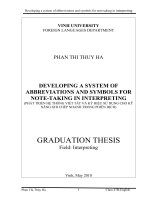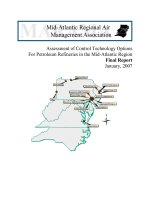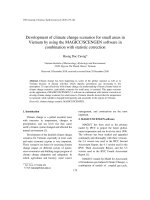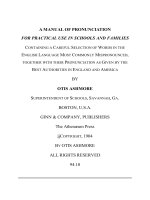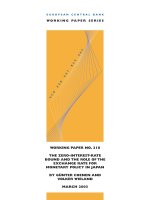Laser surface structuring of biocompatible polymers films for potential use in tissue engineering applications
Bạn đang xem bản rút gọn của tài liệu. Xem và tải ngay bản đầy đủ của tài liệu tại đây (5.33 MB, 162 trang )
LASER SURFACE STRUCTURING OF BIOCOMPATIBLE
POLYMER FILMS FOR POTENTIAL USE IN TISSUE
ENGINEERING APPLICATIONS
TIAW KAY SIANG
(B.Eng. (Hons), NUS)
A THESIS SUBMITTED
FOR THE DEGREE OF DOCTOR OF PHILOSOPHY
DEPARTMENT OF MECHANICAL ENGINEERING
NATIONAL UNIVERSITY OF SINGAPORE
2009
Preface
The thesis is submitted for the degree of Doctor of Philosophy in the
Department of Mechanical Engineering at the National University of Singapore under
the supervision of Professor Teoh Swee Hin and Associate Professor Hong Minghui.
No part of this thesis has been submitted for other degree at other university or
institution. To the author’s best knowledge, all the work presented in this thesis is
original unless reference is made to other works. Parts of this thesis have been
published or presented in the List of Publications shown in page xvi:
i
Acknowledgements
The author would like to express his most sincere gratitude Professor Teoh Swee Hin
and Associate Professor Hong Minghui, for their advice, support and guidance
throughout the entire course of his research study. He is very grateful for the
encouraging comments during the difficult times he has encountered. Through this
research, I believed I have discovered some of my strong points and managed to
improve on my weaknesses. Most importantly, I hope I have met my supervisors’
expectations, and to embark on my career milestone henceforth.
He would like to extend his gratitude to Professor Seeram Ramakrishna and his staffs
for providing experimental facilities, such as the VCA-optima Surface Analysis
System for water contact angle measurement and the Perkin-Elmer Pyris-6 DSC for
thermal properties measurement. He would also like to thank Dr. Zhang Yanzhong for
his support and assistance in the carrying out the measurement of tensile properties of
PCL films using the Instrom Universal Tensile Tester.
Last but not least, he would like to express his most sincere thanks to all graduate and
undergraduate students in BIOMAT, including Mr. Chong Seow Khoon, Mark, Mr.
Chen Fenghao, Dr. Wen Feng, Dr. Bina Rai for their help, advices and encouragement
along the way.
ii
Table of Contents
Preface i
Acknowledgements ii
Table of Contents iii
Summary viii
List of Tables xi
List of Figures xii
List of Publications xx
Chapter 1
Introduction
1.1 General background 1
1.2 Current progress of laser treatment in biopolymers 2
1.3 Research aim and proposal outlines 5
Chapter 2
Literature Review
2.1 Biomaterials engineering 6
2.2 Significance and importance of tissue engineering 12
2.3 Poly(ε-caprolactone) thin films and matrices 16
2.4 Current progress of poly(ε-caprolactone) in biomedical engineering 17
2.5 Introduction to lasers and technology 21
2.6 Laser processing and ablation of materials 22
iii
Chapter 3
Synthesis of PCL thin films
3.1 Introduction 27
3.2 Experimental procedures
3.3.1 Materials 29
3.3.2 Methods of PCL thin film preparation 30
3.3 Film characterization
3.3.1 Optical microscopy 33
3.3.2 Differential scanning calorimetry (DSC) 33
3.3.3 Water permeability 33
3.3.4 Modulus (E), ultimate tensile strength σ
UTS
and elongation (λ) 34
3.4 Results and Discussion
3.4.1 Drawing ability of films 35
3.4.2 Film surface morphology 37
3.4.3 Thermal properties of PCL films 41
3.4.4 Water vapour transmission rate (WVTR) 44
3.4.5 Tensile properties of PCL films 49
3.5 Summary 52
Chapter 4
Theoretical Simulation of Heat Accumulation during Laser Ablation of PCL
Films
4.1. Introduction 54
4.2. Experimental setup
4.2.1. Laser setup 55
iv
4.3. Results and discussion
4.3.1. Laser micro-drilling and melt-related issues on PCL film
using Nd:YAG lasers 56
4.3.2. Theoretical simulation of laser-drilled hole sizes on PCL films 58
4.3.3. Theoretical simulation of temperature rise during laser micro-
drilling 66
4.4. Summary 73
Chapter 5
Laser Micro-structuring of PCL Films
5.1. Introduction 75
5.2. Experimental procedures
5.2.1. Femtosecond and excimer laser systems 78
5.3. PCL film surface characterization and analysis
5.3.1. Optical microscopy 79
5.3.2. Scanning electron microscopy (SEM) 79
5.3.3. Wettability 79
5.4. Results and discussion
5.4.1. Surface modification using femtosecond laser 79
5.4.1.1. Effect of laser pulse energy on laser drilling 80
5.4.1.2. Effect of laser pulse number on laser drilling 82
5.4.2. Surface modification using excimer laser 84
5.4.3. Surface wettability of laser-processed membranes 86
v
5.4.3.1. Wettability of femtosecond laser perforation of PCL
membranes 87
5.4.3.2. Wettability of KrF excimer laser surface modified PCL
membranes 90
5.5. Summary 96
Chapter 6
Laser Degradation Study of PCL
6.1 Introduction 98
6.2 Experimental procedures
6.2.1 Laser systems 102
6.3 PCL Film Characterization
6.3.1 X-ray photon spectroscopy (XPS) 103
6.3.2 Gel permeation chromatography (GPC) 103
6.4 Results and discussion
6.4.1 Laser drilling of PCL films using Nd:YAG laser (at λ=355 nm)
and excimer laser (at λ=248 nm) 104
6.4.2 XPS analysis of PCL film surface chemistry 107
6.4.3 Analysis of molecular weight distribution after laser processing 112
6.5 Summary 116
Chapter 7
Conclusion and Future Directions
7.1 Conclusion and research contributions 117
7.2 Future research directions 121
vi
References 126
vii
Summary
The research scope encompasses the different methods of fabricating the
biocompatible and biodegradable poly(ε-caprolactone) (PCL) thin films through
simultaneous bi-axially drawn films prepared via: 1) conventional solution casting, 2)
spin casting and 3) solvent-free method of hot roll-milling. The purpose of biaxial
drawing is to enhance the mechanical properties of the film. PCL films were shown to
be suitable for membrane tissue engineering applications. However, prior treatment of
sodium hydroxide solution or plasma was required to provide better affinity for cells.
Alternative method to treat the PCL films using different lasers to modify the surface
by creating micro-structures were carried out. In this study, the mathematical modeling
of temperature-rise and heat propagation on the PCL film during the impingement of
laser using different wavelengths and pulse duration was studied and compared with
the actual results. The scope of this thesis ended with the degradation study of PCL
films caused by the irradiation of the lasers.
Biaxial drawing of the PCL sheets into ultra-thin films enhanced both the
tensile strength and modulus. This was largely due to the polymer chain extension and
orientation during the biaxial stretching process. As the thickness of the PCL films
were substantially reduced by the biaxial drawing, the water vapour transmission rate
increased significantly, which subsequently allows better bidirectional gas and
moisture diffusion through the film.
viii
Laser micro-processing on PCL films by Nd:YAG (Neodymium-doped yttrium
aluminium garnate) lasers to create micro-structures and micro-trenches was carried
out. The thickness of the PCL films was found to play an important role in the degree
of melting around the laser spot due to a larger volume at higher thickness.
Temperature-rise modeling of the laser irradiation on PCL film was evaluated and the
results showed that different focusing spot sizes delivered through different lens played
an important role in the cooling rate of the material significantly. The laser which was
delivered through plano-convex lens with long focal length and smaller numerical
aperture experienced a cooling time constant of 2 ms., while an objective lens with
short focal length and high numerical aperture experienced a cooling time constant of
8.4 μs. A slow cooling rate is found to be able to register a high temperature rise of up
to 1200 K while a fast cooling rate registers a temperature rise of 88 K. The different
heat rise can in turn affect the dimensions of the micro-holes produced and the radial
heat flow around the micro-holes region. These theoretical simulation results of heat
propagation explain the actual results of the laser micro-processing on the PCL thin
films.
Femtosecond laser and KrF excimer laser was used to modify the surface by
producing arrays of micro-perforations. Higher pulse energy increased the width of the
Gaussian bean profile and enlarged the micro-pores drilled on the PCL film while
lower pulse number increased the deposition of ejected materials back on the film
surface. These micro-pores, together with the material deposits, were believed to have
caused the rupture of thin liquid membrane that resulted in substantial reduction in the
water contact angle by up to 30%, hence enhancing the surface wettability.
ix
Lasers can also be used to induce chemical modifications through photo-
chemical reactions. This is especially so for UV laser which can cause the breakdown
of polymer chain by the high energy photon absorption. Photo-chemical oxidative
degradation was believed to be the main breakdown mechanism for PCL films exposed
to KrF excimer laser as it exhibited the highest amount of degradation, resulting in
large reduction in number-average molecular weight (M
n
) and weighted-average
molecular weight (M
w
), and hence an increase in polydispersity index. Conversely,
thermo-oxidative degradation was found to have taken place in PCL films processed
by Nd:YAG lasers and the results showed less surface oxidation and changes to the
values of M
n
and M
w
and hence, relatively unchanged polydispersity index.
In conclusion, the work presented in the thesis showed the versatile use of
lasers as a tool for laser micro-structuring and inducing chemical changes on self-
developed PCL thin films. The processed films can be suitable for use on wide array of
applications such as flexible membrane tissue engineering matrices, drug delivery and
cell encapsulation.
x
List of Tables
Table 3.1. Thickness of non-biaxial and biaxial drawn films produced by different
methods. (Page 35)
Table 3.2. Peak temperature, melting enthalpy and percentage crystallinity of the
drawn and undrawn PCL films. (Page 43)
Table 3.3. Values of thicknesses and WVTR of different PCL film. (Page 46)
Table 3.4. Values of modulus (E), ultimate tensile strength σ
UTS
and elongation (λ) of
all types of PCL films. (Page 52)
Table 4.1. Thermal and optical properties of PCL. (Page 67)
xi
List of Figures
Fig. 2.1 Comparison of moduli of elasticity of biomaterials [15]. (Page 10)
Fig. 2.2 Comparison of ultimate tensile strengths of biomaterials [15]. (Page 10)
Fig. 2.3 Comparison of fracture toughness of biomaterials relative to the log (Young’s
modulus) with bone as the reference [15]. (Page 11)
Fig. 2.4 Fatigue strengths (in air) of common alloys used as implants [15]. (Page 11)
Fig. 2.5 Five core technologies (biomaterials, cells, scaffolds, bioreactors, and medical
imaging) required for tissue engineering [15]. (Page 13)
Fig. 2.6 Chemical Structure of PCL and its ester linkage. (Page 16)
Fig. 2.7 UV laser micro-machining process [59]. (Page 24)
Fig. 2.8 Simplified photo-chemical ablation model [59]. (Page 24)
Fig. 2.9 Ablation of materials by a long pulse laser at a pulse duration > 10 ps [61].
(Page 25)
Fig. 2.10 Ablation of materials by ultra-short pulse laser at a pulse duration < 10 ps
[61]. (Page 26)
xii
Fig. 3.1 Schematic drawing showing the stages of initial preparation of PCL thin films
using methods of solvent casting, two-roll milling and spin casting. (Page 32)
Fig. 3.2. Stages of heat treatment and biaxial drawing. (Page 32)
Fig. 3.3 Morphology from polarizing microscope showing different orientations of the
fibrillar network of the biaxial drawn films by different fabrication methods.
(A: spin casting; B: two-roll milling; C: solvent casting) at centre (1) and side (2).)
(Page 37)
Fig. 3.4. Morphology from polarizing microscope showing fibrils extending outwards
radially from the undrawn material of biaxial stretched spin cast PCL films at centre
region. (Page 39)
Fig. 3.5. AFM images of the biaxial drawn films by different fabrication methods
(A: spin-casting; B: two-roll milling; C: solventcasting) at the side regions. (Page 40)
Fig. 3.6. AFM images of the biaxial drawn films by different fabrication methods
(A: spin-casting; B: two-roll milling; C: solventcasting) at the side regions. (Page 41)
Fig. 3.7. DSC profiles of drawn and undrawn PCL films. (Page 43)
Fig. 3.8. WVTR plotted against film thickness for various film types. (Page 49)
Fig. 3.9. Stress-strain curves of PCL films fabricated by different methods. (Page 50)
xiii
Fig. 4.1 Schematic setup for the laser micro-processing of PCL films. (Page 56)
Fig. 4.2. Laser micro-drilling of micro-pores on bi-axial drawn PCL film at a laser
fluence of 25 J/cm
2
and pulse repetition rate of 4000 Hz for 2000 pulses using a plano-
convex lens with a focal length of 50 mm. (Page 57)
Fig. 4.3. Laser micro-drilling of micro-pores on bi-axial drawn PCL film at a laser
fluence of 25 J/cm
2
and pulse repetition rate of 10000 Hz for 5000 pulses using an
objective lens with a focal length of 4 mm. (Page 58)
Fig. 4.4 Laser micro-drilling of micro-pores on 1 μm thick spin-cast PCL film at a
laser fluence of 25 J/cm
2
and pulse repetition rate of 10000 Hz for 5000 pulses using
an objective lens with a focal length of 4 mm. (Page 59)
Fig. 4.5. Relationship between the dimension of the micro-pore with laser fluence,
using 9 μm and 2 μm thick PCL films for 2500 pulses at a repetition rate of 5000 Hz.
(Page 63)
Fig. 4.6. Relationship between the dimension of the melt-width with laser fluence
using 9 μm and 2 μm thick PCL films for 2500 pulses at a repetition rate of 5000 Hz.
(Page 64)
Fig. 4.7. Relationship between the dimension of the micro-pore and melt-width with
pulse number at a laser fluence of 50 J/cm
2
. (Page 65)
xiv
Fig. 4.8. Laser micro-drilling of micro-pores on 12 μm thin bi-axial stretched PCL film
with single shot exposure using 532 nm laser at a laser fluence of 220 J/cm
2
. (Page 68)
Fig. 4.9. Temperature decay as a function of time for a single pulse exposure at r=0.
for 532nm laser at a fluence of 220 J/cm
2
on PCL film with a =10μm. (Page 68)
Fig. 4.10. Temperature rise calculated for a single pulse shot for 532 nm laser at a
fluence of 220 J/cm
2
on PCL film with a = 10 μm. (Page 69)
Fig. 4.11. Temperature decay as a function of time for a single pulse exposure at r = 0
for 355 nm laser at a fluence of 25 J/cm
2
on PCL film at 4 kHz and a = 20μm.
(Page 70)
Fig. 4.12 Temperature rise calculated for 355nm laser irradiatated on PCL film using
plano-convex lens with focal length of 50 mm at a fluence of 25 J/cm
2
on PCL film
with a = 20 μm at 4 Khz and 2000 pulses. (Page 71)
Fig. 4.13. Temperature decay as a function of time for a single pulse exposure at r = 0
for 355 nm laser at a fluence of 25 J/cm
2
on PCL film at 10 kHz and a = 2μm.
(Page 72)
Fig. 4.14. Temperature rise calculated for 355nm laser irradiatated on PCL film using
objective lens with focal length of 4 mm and N.A. 0.4 at a fluence of 25 J/cm
2
on PCL
film with a = 2 μm at 10 Khz and 5000 pulses. (Page 73)
xv
Fig. 5.1. Microscopy images of laser perforation on PCL membrane with different
pulse energies at a pulse number of N = 2 [69]. {(A) E
pulse
= 500 µJ, (B) E
pulse
= 400
µJ, (C) E
pulse
= 300 µJ, (D) E
pulse
= 200 µJ, (E) E
pulse
= 150 µJ and (F) E
pulse
= 100 µJ}
(Page 81)
Fig. 5.2 Microscopy images of laser perforation on PCL membrane with different
pulse numbers at a pulse energy of E
Pulse
= 600 µJ [69]. {(A) N = 200, (B) N = 100,
(C) N = 20 and (D) N = 5.} (Page 82)
Fig. 5.3. SEM images of laser perforation on PCL membrane with different pulse
numbers at a pulse energy of E
Pulse
= 600 µJ [69]. {(A) N = 100, (B) N = 20
and (C) N = 5.} (Page 83)
Fig. 5.4. (A-C): Microscopy images of laser surface-patterned PCL thin film with 248
nm KrF excimer laser at 210 mJ energy, 2 Hz repetition rate, and 300 s irradiation
time. (D-F): Micrographs of the same laser surface-patterned PCL thin film observed
with backlight illumination. (Page 85)
Fig. 5.5. SEM images of the laser-patterned PCL thin film. (Page 86)
Fig. 5.6: Illustration of contact angle on surface of solid substrate. (Page 87)
Fig. 5.7. Graph of changes in water contact angle of membrane at N = 200 with E
Pulse
at time t = 0 s and t =100 s. (Page 88)
xvi
Fig. 5.8. Graph of changes in water contact angle of membrane at N = 200 with respect
to external hole diameter at time t = 0 s and t = 100 s. (Page 89)
Fig. 5.9. Graph of changes in water contact angle of the membrane at E
Pulse
= 500 µJ
with N at time t = 0 s and t = 100 s. (Page 90)
Fig. 5.10a. Graphs of water contact angle plotted for a 2 minute test duration for
biaxially-stretched ultra-thin PCL film irradiated with 248 nm KrF excimer laser at a
repetition rate of 10 Hz, 78 mJ energy and pulse number of 4800. (Page 91)
Fig. 5.10b. Graphs of water contact angle plotted for a 2 minute test duration for
biaxially-stretched ultra-thin PCL film irradiated with 248 nm KrF excimer laser at a
repetition rate of 10 Hz, 78 mJ energy and pulse number of 6000. (Page 92)
Fig. 5.10c. Graphs of water contact angle plotted for a 2 minute test duration for
biaxially-stretched ultra-thin PCL film irradiated with 248 nm KrF excimer laser at a
repetition rate of 10 Hz, 78 mJ energy and pulse number of 7200. (Page 92)
Fig. 5.11a Graphs of water contact angle plotted for a 2-minute test duration for
biaxially-stretched ultra-thin PCL film irradiated with 248 nm KrF excimer laser at a
repetition rate of 10 Hz, 171 mJ energy and pulse number of 4800. (Page 94)
Fig. 5.11b Graphs of water contact angle plotted for a 2-minute test duration for
biaxially-stretched ultra-thin PCL film irradiated with 248 nm KrF excimer laser at a
repetition rate of 10 Hz, 171 mJ energy and pulse number of 6000. (Page 95)
xvii
Fig. 5.11c Graphs of water contact angle plotted for a 2-minute test duration for
biaxially-stretched ultra-thin PCL film irradiated with 248 nm KrF excimer laser at a
repetition rate of 10 Hz, 171 mJ energy and increasing pulse number of 7200. (Page 95)
Fig. 6.1. Pictures of laser surface-patterned PCL thin films showing (A) micro-
perforations using Nd:YAG laser (at λ = 355 nm) with uniformed array of micro-size
perforations on 1 µm thick PCL film; (B) ‘donut-like’ array of micro-size perforations
on 10 µm thick PCL film; (C) micro-wells formed using KrF excimer laser (at λ = 248
nm) with mask; (D) laser “direct-writing” on PCL film forming micro-channels of
about 2 µm wide. (Page 106)
Fig. 6.2. UV-Vis spectrum showing optical absorption of PCL film across wavelengths
of 200 – 1400 nm. The absorption coefficient values correspond to optical absorption
of PCL film at laser wavelengths of 248 nm, 355 nm, 532 nm and 1064 nm, in
descending order. (Page 108)
Fig. 6.3. XPS narrow-scan spectra showing the various species compositions of laser-
processed and pristine PCL films. A significant change was observed when the PCL
film was exposed to KrF excimer laser (at λ = 248 nm) in which the composition of
the main chain C-H dropped to 57.6% while that of the species C=O and O-C=O
increased to 34.1% and 8.3% respectively. The rest of the films subjected to Nd:YAG
lasers (at λ = 355, 532, 1064 nm) showed less compositional changes to C-H, C=O and
O-C=O. (Page 110)
xviii
Fig. 6.4. Comparison of values of weight-average (M
w
) and number-average
molecular weight (M
n
) and polysdispersity index of pristine and irradiated PCL films
at various laser wavelengths. (Page 115)
Fig. 7.1. A galvanometer laser scanner uses a mirror pair sized to the input beam
aperture over a range of rotation angles for the required scan field. (Page 122)
Fig. 7.2 Schematic design of microlens array laser micro-processing and micro-
patterning. (Page 124)
xix
List of Publications:
International journals:
1. K.S. Tiaw, P.S. Tan, M.H. Hong, Z.B. Wang, S.H. Teoh. Effect of nanosecond and
femtosecond pulse duration of laser processing of thin biodegradable polymeric
film. Proceedings of SPIE, 2004, 5662: p. 684-688.
2. K.S. Tiaw, S.W. Goh, M.H. Hong, Z. Wang, B. Lan, and S.H. Teoh, Laser surface
modification of poly(e-caprolactone) (PCL) membrane for tissue engineering
applications. Biomaterials, 2005. 26(7): p. 763-769.
3. M.H. Hong, Q. Xie, K.S. Tiaw and T.C. Chong. Laser Singulation of Thin Wafers
& Difficult Processed Substrates: A Niche Area over Saw Dicing. Journal of Laser
Micro/Nanoengineering, 2006. 1(1): p. 84-88.
4. K. S. Tiaw, S.H. Teoh, R. Chen and M.H. Hong, Processing Methods of Ultrathin
Poly(
-caprolactone) Films for Tissue Engineering Applications.
Biomacromolecules, 2007: 8(3): p. 807-816
5. K.S. Tiaw
, M.H. Hong and S.H. Teoh. Precision laser microprocessing of
polymers. Journal of Alloys and Compounds, 2008. 449(1-2): p. 228–231.
xx
6. K.S. Tiaw, M.H. Hong and S.H. Teoh, Laser Microstructuring of Poly(ε-
caprolactone) Thin Films: Study of Surface Chemistry, Degradability and Potential
Applications in Tissue Engineering. 2009. (Submitted)
Conferences:
1. M.H. Hong, S.M. Huang, W.J. Wang, K.S. Tiaw, S.H. Teoh, B. Luk'yanchuk, and
C.T. Chong. Unique functional micro/nano-structures created by femtosecond
laser irradiation. Proceedings in Advanced Optical Processing of Materials held at
the MRS Spring Meeting. April 22 - 23, 2003
2. K.S. Tiaw, S.W. Goh, M.H. Hong, Z. Wang, B. Lan, and S.H. Teoh. Laser surface
modification of poly(e-caprolactone) (PCL) membrane for tissue engineering
applications. Proceedings in International Conference on Materials for Advanced
Technologies. December 7 - 12, 2003. Singapore. (Oral)
3. K.S. Tiaw, P.S. Tan, M.H. Hong, Z. Wang, and S.H. Teoh. Effect of nanosecond
and femtosecond pulse duration of laser processing of polymeric membrane.
Proceedings in 5th International Symposium on Laser Precision Microfabrication -
Science and Applications. May 11 - 14, 2004. Nara, Japan. (Poster)
4. K.S. Tiaw, S.H. Teoh, and M.H. Hong. Ultra-short pulse laser processing of ultra-
thin poly(e-caprolactone) films. Proceedings in 1st Nano-Engineering and Nano-
Science Congress. July 7 - 9, 2004. Singapore. (Poster)
xxi
xxii
5. K.S. Tiaw, M.H. Hong, T.S. Ong, Q. Xie, S.H. Teoh, Laser Micro-structuring of
Newly-developed Ultra-thin Poly(
ε
-caprolactone) Films. Proceedings in 6th
International Symposium on Laser Precision Microfabrication - Science and
Applications. April 4 - 8, 2005. Williamsburg, Va, USA. (Poster)
6. K.S.Tiaw, M.H. Hong, S.H. Teoh, Precision Laser Micro-processing of Polymers.
Proceedings in 1st International Symposium on Functional Materials. December 6
– 8, 2005. Kuala Lumpur, Malaysia. (Poster)
Chapter 1:
Introduction
1.1 General Background
Current applications of biomaterials for tissue engineering (TE) involve the
combination of a scaffold with cells and/or biomolecules that promote the repair and
regeneration of tissues. These TE constructs are under vigorous exploration and have
resulted in the incessant emergence of diverse strategies. However, despite intense
efforts, the ideal tissue engineered construct has yet to be discovered. From an
engineering perspective, significant advances in scaffold design and fabrication have
evolved in the past decade. Our interdisciplinary group at the National University of
Singapore has evaluated and patented the parameters necessary to process
polycaprolactone (PCL) and PCL-based composites by fused deposition modeling
(FDM). Other cutting-edge technologies, such as biaxial-stretching and electro-
spinning, have also been utilized to manufacture PCL-based biomaterials with unique
macro- and nano-architectures that are useful for drug, growth factor and cell delivery
applications. Lasers are also used to modify the surface of the biaxially drawn PCL
films to enhance its purpose.
1
1.2 Current progress of laser treatment in biopolymers
At present, polymers are becoming very versatile and are used in various
industries, such as the food, electronics, automobile, medical and other manufacturing
industries [1].
Polymers are gaining more attention as their physical properties can be
enhanced for higher load-bearing applications, light weight, cheaper to produce and
widely available. To extend its functional usage, research in the surface modifications
of the polymers has become more intense. Most polymers surfaces are inert,
hydrophobic in nature, and usually have a low surface energy. Therefore, they do not
possess specific surface properties that are needed in some applications. The purpose
of surface treatment are: to modify the surface layer of a polymer by introducing some
functional groups into the surface to increase surface energy, to introduce surface
cross-linking, to improve its wettability, to modify sealability, to adjust dye uptake and
to be resistance to glazing. All these surface treatments are carried out while the
desirable bulk properties of the polymers are retained [2]. Surface treatment can also
be used to improve the barrier characteristics of polymers and impart it with
antimicrobial properties.
Surfaces of polymeric membranes have been modified by chemical means for
years, but these methods require rigorous process control and can lead to undesirable
surface changes, such as severe surface roughening, excessive surface damage (cracks,
pitting, etc.) and surface contamination. They may also cause environmental problems
due to the chemical agents used.
2


